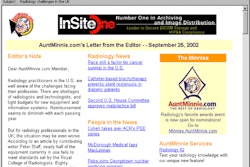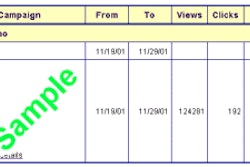Timely and accurate revenue capture is the lifeblood of the U.S. radiology practice. Timely revenue is crucial because many practices are faced with bare-bones costs and a delayed cash flow, both of which threaten viability. Accurate revenue capture is critical because the penalties for inaccurate coding are catastrophic enough to shutter the doors of any facility.
Coupling revenue optimization with coding compliance assurance is a sword that managers can wield to cut costs and improve performance in their practice. Ideally, a revenue and compliance audit will cover each account, from the date of service to the date the account is closed.
"All aspects of billing and collections have optimization and compliance implications, and altering processes to improve either aspect will affect both," said Dr. Gary Dorfman, president and chief medical officer of Health Care Value Systems in North Kingstown, RI.
In a presentation at the 2002 Radiology Business Management Association Summit in Naples, FL, Dorfman outlined the value of tying optimization to compliance. This begins with integrating these processes into the daily, weekly, monthly, and annual workflow of a radiology practice.
Show me the money
Charge-entry status verification should be performed on a daily basis, Dorfman said. Charges and collections need to be examined every week, and exams, charges, and transactions should be reviewed both monthly and annually. This includes collections, adjustments, write-offs, and refunds.
Examining payment denials, delays, and discounting can indicate if there are payor-specific issues or process-specific issues. These can be as simple as a single current procedure terminology (CPT) code at a site of service that delays payment by one payor. Process-specific issues indicate that a retooling of procedure workflow may be in order.
Facility managers may want to perform an analysis of such data as revenue-cycle times per CPT code; the percentage of denials of submitted claims; and the length of time a resubmitted claim takes per provider. They might also consider creating a clean-claim checklist on a per-provider basis.
In addition to payor-specific account information, a manager will also want an overview of the practice by site, by modality, by CPT, and by referral source. To gain a better picture of the fiscal health of the practice, this data should be captured each month and then trended on a rolling and annual basis. This will permit seasonal variations to become apparent, and will allow benchmarking data on a same-period previous-year basis.
Of equal importance to the marketing efforts of the firm, this hard data will show which referring physicians are ordering what services, and with what frequency. This knowledge can help a practice tailor its outreach efforts to the physician groups and hospitals where it can be most effective.
The administrator should also audit unbilled services (readings versus exams performed), trend the accounts receivable on a monthly and annual basis, and use the knowledge to make improvements in the coding and data-transfer mechanisms of their institution. On a fundamental level, they will need to review and revise the charge master every year.
"You have to make sure that the codes on the charge master are exactly appropriate to what your practice does," Dorfman said.
Shaking the money tree
At some point, a manager will exhaust available inside resources for revenue optimization and compliance assurance. Chances are, there’s still money being left on the table, and the return on investment is not functioning at maximum capacity. At this time, an audit and review by an outside contractor can provide a group with expertise not otherwise available. An outside audit should be performed at least once by a practice; some will want to have the service performed on an annual basis.
"An outside audit can avoid interfering with the day-to-day workflow of your organization and can provide independent verification of what you know or suspect," Dorfman said.
When selecting an outside revenue and compliance audit firm, caution is called for, he said. Administrators should avoid any general accounting or compliance experts, as these firms can offer complimentary services but not a complete service. Managers should also beware of entities with potential ulterior motives, such as billing companies, or groups who want to upsell additional consulting prior to a demonstrated need on the basis of reviewed data.
Once the auditors collect the data, an executive summary and an actionable report must be generated. "Don’t settle for a report that says ‘We think you might have an issue with x or y,’ or ‘Here’s some codes you might want to pay attention to,’" Dorfman advised.
The report should prioritize opportunities and provide strategies for the administrator. It should have a detailed description of each analysis performed, and the supporting data should be in a useful, easy-to-understand format. Lastly, it should integrate revenue and compliance, as well as the professional and technical components of a practice’s business.
Compliance assurance should focus on a review of what is and what is not a medical necessity by payor standards. In addition, it should examine all coding for modifier uses, upcoding, fragmentation, and secondary services without the necessary primary services billed.
"The idea is to find the areas where your practice has an Achilles heel and then fix them," said Dorfman.
He believes that $500,000 to $2 million can be recovered in enhanced annual revenue at a facility that performs between 125,000 to 500,000 exams annually. This can be accomplished by diligently examining the accounts receivable, billing-cycle times, denied claims, and paid, pended, and written-off claims.
A final report that includes both internal and external audits can be a very powerful tool for a practice. The data can be used to conduct a performance assessment review of technical staffing and asset management. A trend analysis derived from the report can be used for market analysis and strategic planning for a practice’s marketing and growth. And the compliance-audit component can identify areas of vulnerability for a firm and permits proactive fixes.
Most importantly, revenue optimization and compliance assurance means that a practice is not leaving money on the table at the end of the day. "Getting every last penny I’m owed for what I do is a very important thing," Dorfman said.
By Jonathan S. BatchelorAuntMinnie.com staff writer
July 15, 2002
Related Reading
Billing process review can reap revenue rewards, March 28, 2002
Budget monitoring reveals practice’s financial health, January 24, 2002
Detailed documentation delivers dollars and sense, July 31, 2001
Revenue review revitalizes reimbursement, June 19, 2001
Copyright © 2002 AuntMinnie.com



















